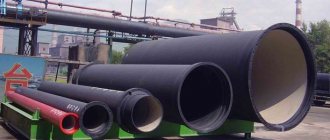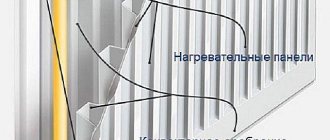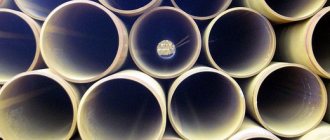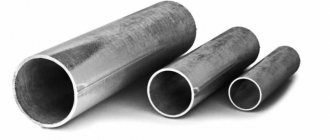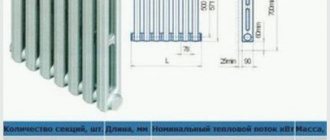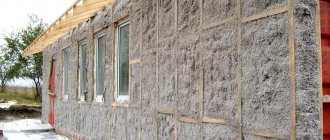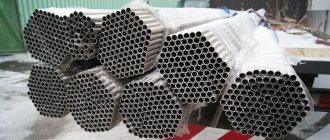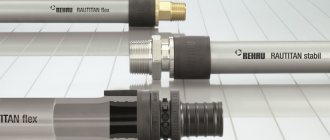Types of pipeline
Several types of metal products are used in heating and water supply systems:
- black steel pipes - steel of different grades is used in production, but it is not corrosion resistant. Such rolled metal products require additional protection - painting, for example;
- galvanized steel pipes - products are coated with a layer of zinc. The latter forms a galvanic couple with iron and is destroyed by an electrochemical reaction, protecting the steel from corrosion. Obviously, the service life according to SNiP and GOST for such a model is much longer;
- stainless steel – alloys with the addition of nickel and chromium. Depending on the size of the alloying additive, steel can be resistant to corrosion under normal conditions, is characterized by increased resistance, which allows use in sea water, for example, and also does not oxidize under the influence of not only moisture, but also high temperature. The product does not need protection, however, its cost is noticeably higher;
- copper - rare, but used in domestic conditions. They are distinguished not only by their resistance to corrosion, but also by their disinfecting properties.
Each option from the list can be used for water supply, gas pipelines, heating, and not only water, but also steam. However, their service life will vary.
Durability options
Industrial production offers consumers polypropylene pipes of various diameters and wall thicknesses. These characteristics determine the scope of application of plastic products.
Each category of products has its own markings and corresponding technical characteristics. For polypropylene products, the letter marking PN and digital marking are used, indicating the maximum permissible pressure.
Categories of polypropylene pipes:
- PN 10. Polypropylene pipes with a diameter of 20 to 250 mm are produced under this marking. They are designed for transporting and supplying cold and warm liquids and gases under pressure. The maximum permitted temperature is 45°C, the optimum for the stated service life is 25°C. Pressure is indicated by the number 10 and means 1 MPa (1 MegaPascal, which is about 10 atmospheres).
- PN 16. The purpose of the products is similar to the first. Permitted temperature - 60°C, pressure 16 atmospheres.
- PN 20. This category of products allows their use for hot and cold water supply, water heating, and drainage. Maximum temperature 75°C, permissible pressure 2 MPa.
- PN 25. Products in this category are made with reinforced walls with aluminum foil or fiberglass. They have a more rigid structure and are less susceptible to thermal expansion and deformation. Used for installation of heating (water) and hot water supply systems. Withstands pressure of 24 atmospheres.
When choosing products, you should pay attention only to the labeling. The color of the pipes does not convey information, with the exception of black ones. Black polypropylene pipes are more resistant to ultraviolet radiation.
Black steel for water pipe
Alas, this option is not particularly durable. Even with the most careful painting and care, they will rust over time. The fact is that after the construction of communications, individual fragments turn out to be inaccessible, and it turns out to be impossible to update the paint, for example.
In addition, black steel loses its smoothness quite quickly. And this leads to the fact that the water-gas or heating pipe “overgrows” quite quickly: first very small debris and salt deposits are retained on the unsmooth surface, and then increasingly larger particles of rust, fibers, and lime deposits. The rate of sediment accumulation is directly proportional to water hardness.
Constant contact with moisture - in the bathroom, for example, in the toilet, leads to faster destruction of the material, which is reflected in SNiP standards. Here the weak link is often the seams: the first fistulas appear precisely on the welds and threads, where the wall thickness decreases.
Standard operating times are:
Installation rules
Couplings, tees and other fittings used in assembling a galvanized pipeline must be made of galvanized steel.
First, mark the joints. Take into account that when joining with a coupling, the ends of the pipes should be at a distance of 3-4 mm from each other.
Lay out the tools prepared in advance and the purchased connecting fittings.
Welding connection
To obtain a high-quality weld, first clean the joint from the galvanized layer and carry out welding work as usual. After welding, a spray containing zinc is applied to the unprotected area.
An option is to use special fluxes. During welding, flux draws off excess heat and prevents the zinc layer from evaporating from the edges of the outlet.
When using manual electric arc welding, it is better to use rutile-coated electrodes.
Threaded assembly
Prepare the bends: cut them to the required size, file the edges.
Install the desired die into the tool and prepare the thread.
Optimally, you need to make 7 turns.
A similar operation is performed with another pipe.
Strands of flax are wound outside the turns and the elements are connected using a coupling. The connecting element is secured with a locknut.
No welding or threading
A coupling can be installed. One such design is the Gebo coupling, which is actively used for joining polyethylene pipes.
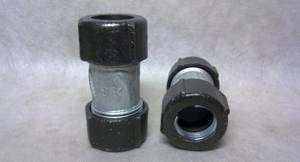
Here, also, a nut and compression rings with a seal are put on the ends of the pipes in a certain sequence. Next, the nut is tightened and a long-term and reliable connection is obtained.
Galvanized pipes with quick-release connections have appeared on the market, which can be used in many areas, including the installation of drinking water pipelines.
Cink Steel
This material is much more resistant to corrosion, which significantly extends the standard time. The most significant destructive factor here is only the welded connection, if for some unknown reason the installation is carried out by welding. The photo shows water and gas steel pipes.
In fact, this installation method is prohibited: the zinc completely burns out during welding, and accordingly, the seams remain completely defenseless against rust.
Galvanized steel products overgrow much more slowly. Firstly, the smoothness of the wall is much higher, and secondly, there is much less “garbage” itself - particles of rust, scale, sand. But if the taps in the plumbing system are not fully opened and there is not a sufficiently dense flow of water, scale and sand can accumulate.
The service life of the product according to GOST is as follows:
- risers and connections in cold water supply systems are in use for 30 years;
- the service life of steel heating pipes in a house with a closed system is 20 years;
- an open heating system will last 30 years.
It is allowed to construct a gas pipeline from galvanized pipes. But there is still a nuance: unlike plumbing systems, the gas pipeline must be one-piece, which requires welding. And the connection destroys zinc at the junction. On the other hand, gas pipelines, like water pipelines, are coated with polymer paint, which prevents corrosion.
In fact, galvanized steel pipes for both water supply and heating last 50–70 years.
Copper
The next metal on our list is copper.
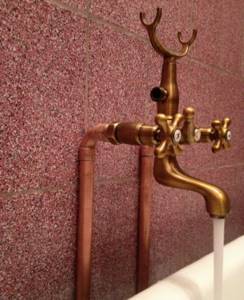
Copper water supply: stylish and durable
How long can these metal hot water pipes last? There are no regulatory documents establishing specific service periods. Manufacturers promise a vague “50+” years.
In practice:
- The oldest copper water pipes have been in service for more than a century and are still in perfect condition;
- Copper does not degrade over time, is not subject to corrosion and is only afraid of significant mechanical stress: the metal is very plastic, and the pipe walls are only about a millimeter thick.
Destructive factors
As they say in the hero city of Odessa, “there are some”:
- The service life of copper plumbing may be reduced if press fittings with rubber O-rings are used instead of soldering when installing it. Over 20-30 years, rubber loses its elasticity (primarily in hot water) and is capable of leaking;
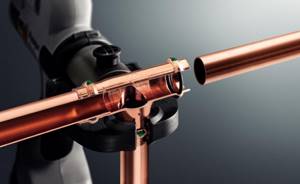
Press fittings for copper pipes. The service life of the water supply is limited by the durability of the O-rings
- Banal erosion can lead to destruction of the walls of copper pipes. At high flow rates, sand and other suspended matter rapidly destroy soft metal;
Note: the problem is solved by installing coarse filters and limiting the water flow speed to 2 m/s.
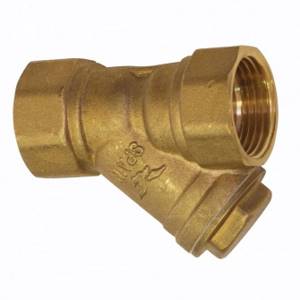
The coarse filter at the entrance to the house is capable of purifying water from sand and suspended matter.
- Theoretically, water hammer and freezing of water in it can break a copper water supply. However, the water hammer must be truly extreme (the destructive pressure for copper pipes is 200 - 240 atmospheres), and defrosting must be repeated at least 5-6 times: the plasticity of copper allows it to withstand a slight change in diameter or length without destruction.
Service life of steel heating pipes
Any material wears out over time, but this time can be very different and depends on the load, on additional factors and, of course, on the quality of the product itself. The standard service life of steel water pipes largely determines their purpose. Types of pipelines Several types of metal products are used in heating and water supply systems: black steel pipes - steel of different grades is used in production, but it does not have corrosion resistance.
How to convince residents to pay contributions for major repairs and what to do if there is no money for it? In the article we will talk about the types of metal pipes, their features and service life - both those prescribed in regulatory documents and real ones. To help the Criminal Code, we also provide a list of mandatory work that must be carried out as part of the maintenance of water pipelines in multi-storey buildings. Previously, during construction, exclusively metal communications were used, which continue to be used in a significant part of the apartment complex. As the resource is exhausted, they are replaced with modern materials. This is a long process that will continue in the public utilities sector for many more decades.
Properties of polypropylene products

Water pipes and fittings made of polypropylene have the following set of advantages:
- The ability to withstand the high temperature of the transported substance (up to 95 degrees Celsius), so polypropylene pipes can be used not only to transmit cold, but also hot water.
- Very low cost. This applies both to the pipes themselves and to their installation. Polypropylene water supply will cost the buyer less than all others.
The disadvantages of this material include the difficult process of installing dismountable connections in pressure systems. The method of installing polypropylene pipes is based on either gluing joints or soldering. To arrange a dismountable unit, you can use a special fitting, which, in addition to a polypropylene body, also has a metal fitting.
Service life of steel structures
And she really wanted to get a link to some official document. We actually managed to find something. The only point is that this order concerns the organization of major repairs of residential buildings in the city. This regulatory act establishes the following service life of steel structures: 1. For central heating pipelines - 30 years. For water supply and sewer steel pipelines - 15 years. The same galvanized steel pipes will last twice as long as 30 years.
For steel enameled bathtubs and sinks - 15 years. For drainpipes made of galvanized steel - 15 years, for drainpipes made of black steel - 5 years. For roofing: and from black roofing steel - 15 years. As we can see, according to this document, the average service life of steel residential building structures is 15 years. In the case of water pipes, during the first years of operation, the inner surface of the pipe becomes overgrown, and wet condensation forms on the surface.
Moreover, this type of pipe can withstand strong dynamic loads. The service life of galvanized steel structures is much longer, thanks to the anti-corrosion coating.
WATCH THE VIDEO ON THE TOPIC: Plastic Heating Pipes from 1963. What happened to them after 55 years?
Advantages and disadvantages
Galvanized pipes have many more advantages than disadvantages.
The main ones:
- Rust resistance.
- Long service life.
- High strength.
- Good throughput due to smooth walls.
- Quite a high operating temperature – 140°C.
This type of pipe also has disadvantages:
- Galvanized pipes cannot be welded using traditional methods; they are susceptible to corrosion if the zinc protective layer is damaged.
- The cost of galvanizing is higher than that of ordinary black pipes.
- High thermal conductivity.
Service life of heating pipes
What factors limit the service life of VGP pipes without anti-corrosion coating: Image Description Steel water supply risers. The first fistula that caused the ceiling to become wet appeared in the Corrosion ceiling. Rusting of the pipe is accelerated by a damaged outer layer of paint, frequent shutdowns of the water supply in this case, the unpainted inner surface of the pipe is in contact with air with high humidity, and poor ventilation in the bathroom (read: consistently high humidity). The first fistulas appear on the longitudinal welds of VGP pipes GOST - electric welded, on threads where the thickness of the pipe walls is minimal, and in ceilings where the surface of the pipes is not ventilated and, in the case of cold water risers, is continuously wetted by the condensate falling on them. The rate of overgrowing is directly proportional to the hardness of water in the region: where it erodes sediment on the way to the consumer, the clearance in the water supply decreases much faster.
Standard service life of steel pipes according to GOST
These materials are susceptible to corrosion. This is their main problem. In order for the pipe to serve faithfully for a long time, it is necessary to apply anti-corrosion materials to its surface. This requires additional financial costs. In addition, they are exposed to aggressive environments, which destroy their structure and make it fragile. This leads to rapid failure of the entire system. Modern heating pipes are made of polypropylene or polyethylene. Modern pipes for heating and water supply are made of metal-plastic, polypropylene and polyethylene. These materials do not corrode, and aggressive environments have virtually no harmful effects on them. They are ideal for organizing a heating system and water supply system in the house.
Odnoklassniki It is very difficult to name those areas in which steel pipes are not used. They are used in oil pipelines, heating mains, main water pipelines, heating systems and many others.
What is galvanizing
The main disadvantage of iron bends is their rapid rusting. To protect the metal from rust, it is galvanized. The steel surface is coated with a layer of zinc, resulting in the formation of a protective film that does not allow oxygen to reach the metal and prevents the corrosion process.

The thicker and more durable the coating, the longer the galvanized product will last.
